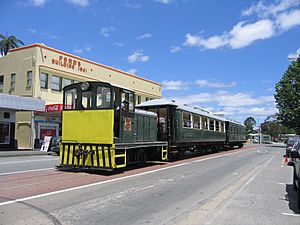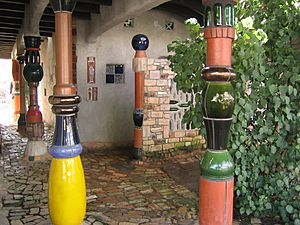Kawakawa, New Zealand facts for kids
Quick facts for kids
Kawakawa
|
|
|---|---|

The main street of Kawakawa
|
|
| Motto(s):
Train Town
|
|
| Country | New Zealand |
| Region | Northland Region |
| District | Far North District |
| Ward | Bay of Islands-Whangaroa Ward |
| Community | Bay of Islands-Whangaroa |
| Subdivision | Kawakawa-Moerewa |
| Electorates |
|
| Area | |
| • Total | 1.73 km2 (0.67 sq mi) |
| Population
(June 2023)
|
|
| • Total | 1,670 |
| • Density | 965/km2 (2,500/sq mi) |
| Postcode(s) |
0210
|
Kawakawa is a small town in the Bay of Islands area of the Northland Region in New Zealand. It's often called "Train Town" because a railway line runs right through its main street! The town grew in the 1860s when coal was found nearby. Even though coal mining stopped in the early 1900s, Kawakawa is still an important service town for local farms. The town gets its name from the kawakawa shrub, which is a native plant.
Contents
A Look at Kawakawa's Past
Kawakawa began to grow when coal was discovered in 1861. At first, horses pulled carts of coal from the mines to the Taumarere wharf. This was a special track called a tramway.
The Railway's Story
In 1871, the tramway was improved and two steam trains were bought. This made it a proper railway. Later, in 1884, a new railway line opened from Kawakawa to Opua. This new line replaced the old one to Taumarere. The area was also known for digging kauri gum in the late 1800s and early 1900s.
By 1899, about 1,000 people lived in Kawakawa. Most of the town was built on a hillside. Sadly, a big fire in 1899 destroyed almost all the buildings. But the town was rebuilt on flat land, right next to the railway tracks. The current railway station was built in 1911. A railway line connecting Kawakawa south to Whangārei was also finished in 1911. Coal mining in Kawakawa stopped early in the 20th century.
Marae: Important Meeting Places
Kawakawa has four special meeting places called marae. These marae are linked to the hapū (sub-tribes) of Ngāpuhi. They are all located about 5 kilometers south of the town in Waiomio.
Mohinui Marae and its meeting house, Hohourongo, are connected to Ngāti Hine and Ngāti Kahu o Torongare. Kawiti Marae and its Te Tawai Riri Maihi Kawiti meeting house are also linked to Ngāti Hine. Miria Marae with its Te Rapunga meeting house, and Te Kotahitanga with its meeting house of the same name, are also connected to Ngāti Hine. These marae are very important for the local Māori community.
People of Kawakawa
Kawakawa covers an area of 1.73 square kilometers. In the 2023 New Zealand census, 1,482 people lived here. This was a small increase from the 2018 census.
The median age in Kawakawa is 34.2 years old. This is a bit younger than the national average in New Zealand. About a quarter of the people living in Kawakawa are under 15 years old.
Many different cultures make up Kawakawa. About 45% of people are European (Pākehā), and about 71% are Māori. Some people identify with more than one ethnicity. English is spoken by most people, and about 27% also speak the Māori language.
Cool Things to See and Do
Kawakawa is famous for a few unique things!
Train Town Fun
The town is known as "Train Town" because the Bay of Islands Vintage Railway runs right down the middle of its main street! This railway uses part of the old Opua Branch railway line. About 8 kilometers of the 17-kilometer track were reopened in 2008. You can also follow part of the railway on the Pou Herenga Tai – Twin Coast Cycle Trail.
The Hundertwasser Toilets
Kawakawa is also famous for its amazing toilet block. This unique building was designed by an Austrian artist named Friedensreich Hundertwasser. He lived in the town from 1975 until he passed away in 2000. The toilets are a work of art!
Glowworm Caves
Near Kawakawa, in Waiomio, you can visit the Kawiti glowworm caves. These caves are a popular attraction where you can see thousands of tiny glowworms lighting up the dark.
Learning in Kawakawa
Kawakawa has schools for different age groups.
- Kawakawa Primary School is for younger students, from year 1 to year 8.
- Bay of Islands College is a secondary school for older students, from year 9 to year 13. Many students travel by bus from around the Bay of Islands to attend this college.
- Te Mirumiru Early Childhood Education Centre is a preschool that teaches in both English and Māori.
- Te Kohanga Reo o Kawakawa is another early childhood center that focuses on teaching completely in the Māori language.
Both the primary school and the college are coeducational, meaning both boys and girls attend.
Well-Known People from Kawakawa
Several notable people have connections to Kawakawa:
- Terryann Clark – a professor
- Kelvin Davis – a politician
- Jack Goodhue – a rugby player
- Pita Paraone – a politician
- Willow-Jean Prime – a politician
- Joe Schmidt – a rugby coach
- Noma Shepherd – a community leader
- Telusa Veainu – a rugby player


